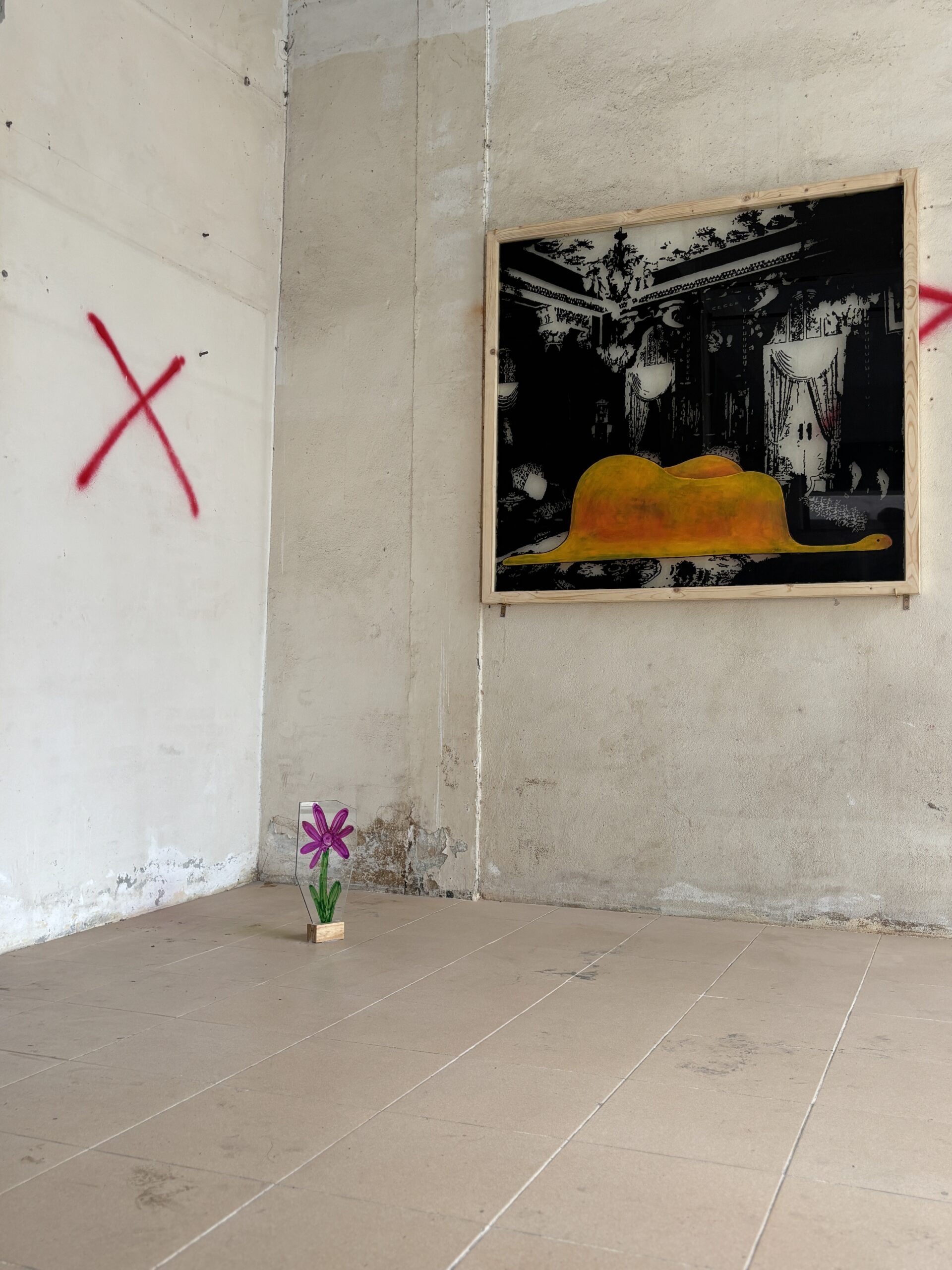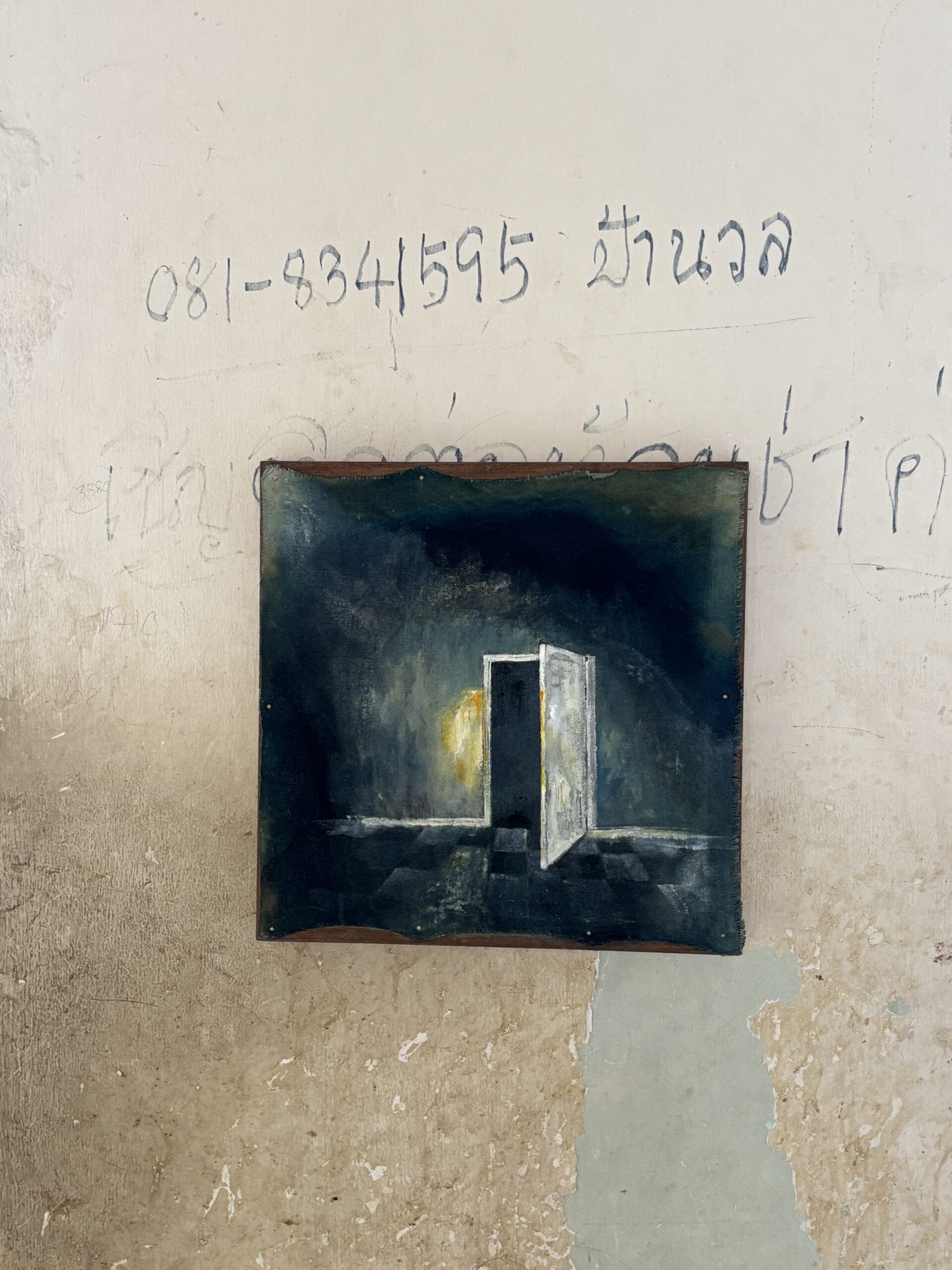Siraphop Phumpuengphut, known by his nickname “Khanun”, which means jackfruit in Thai, is a political prisoner currently serving a two-year sentence in the Bangkok Remand Prison. Khanun was convicted in March 2024 for allegedly insulting the king in a speech he made in November 2020 as part of the youth-led democracy movement. At the time of his conviction, he was an MA student in Political Science with plans to pursue a PhD. Unable to work on his thesis, he sends letters out of prison to his family and friends about prison life, what he is reading, and what he dreams of doing upon release. He adorns his letters with colour pencil drawings of what he sees in prison: stray flowers, cats who wander in and out, the prison walls, and above all, the sky.
Nineteen kilometers away from the Bangkok Remand Prison, Khanun’s drawings are one of the subjects of a site-specific duo exhibition by Paphonsak La-or and Pare Patcharapa. Titled Memory Complex, the two artists have transformed an empty shophouse into three stories of art documenting and dwelling in Thailand’s current time of democratic abeyance.
The exhibit begins on the first floor with Paphonsak’s Cloudy Day. He has layered drawings of trees, prison walls, and skies from several letters written and sent out by Khanun onto one large wooden board, over two metres by two metres. Khanun and other political prisoners use an app called “Domi-mail” to send letters out to family and supporters. An imprisoned person writes (and draws) on a standard fifteen-line piece of prison stationery and hands it in to be censored. Letters that pass are then scanned and sent to recipients outside prison as image files. Letters by Khanun and other political prisoners, such as the award-winning lawyer and human rights defender Arnon Nampa, are often then posted to Facebook and circulated.
Khanun is one of nearly 300 people being prosecuted under Article 112, Thailand’s draconian lèse majesté law, for peaceful expression related to the 2020 protests. Frustrated after five years of military rule (2014–2019) and an election (2019) that changed little, the protestors initially called for a new election and a new constitution. They then added a third demand—reform of the monarchy—which electrified the protests but also made them a target for the state.
Thailand has been a constitutional monarchy since the supposed end of absolutism in 1932. But the monarchy has had an outsize—and difficult-to-question—influence on politics, economy, and law. One of the primary tools placing the monarchy beyond question is Article 112 of the Criminal Code, which provides for three-to-fifteen years imprisonment for lèse majesté, or defamation, insult or threat to the king, queen, heir-apparent or regent. The meaning of lèse majesté has grown so elastic that merely questioning or calling for open discussion of the monarchy, as many of those being prosecuted for the 2020 protests did, has become a crime.
Thailand’s deinstitutionalised democracy movement
Thai conservatives have sought to prevent reformists from putting down roots in society—and it’s worked
The empty shophouse that contains Memory Complex is owned by Chulalongkorn University, the oldest in the country founded as a royal institute to train civil servants and also a major landowner in central Bangkok. The electricity and plumbing have been pulled out of the entire row, perhaps to prepare for redevelopment. The lack of light other than that from the outside also makes the space feel desolate.
The artwork both enhances and interrupts the desolation. The remainder of the first floor contains a series of Paphonsak’s black acrylic paintings on clear glass mixing renderings of key royal and Buddhist sites in Bangkok with elements of both fantasy—the elephant-consuming snake from A Little Prince—and the very real—colorful flowers adorning Khanun’s letters. The effect is for the elements of the fictional stories and the actual life of Khanun to collapse into one another. Is it any less fantastical that people can be imprisoned for many years for peacefully raising questions about a key institution in their polity than a snake could devour two elephants?
A few additional three-dimensional colorful flowers cut out of painted plexiglass are glued to the floor. The flowers ground viewers in the present, and remind us to pay attention so as to not trip and fall.
Climbing up to the second floor, windows emptied of their glass provide a breeze that keeps the thin, translucent cloths suspended from the ceiling that Paphonsak has painted with Khanun’s clouds in constant motion. On the walls, a series of black acrylic paintings on glass—this time of several Van Gogh and Goya works—form the backdrop for the addition of layers of colorful drawings from political prisoner letters. The most devastating of these is a reworking of Van Gogh’s Starry Night, to which Paphonsak has added golden stars that Khanun drew on one of his letters. The stars are not enough to illuminate the night, which rendered in black seems infinite.
Pare Patcharapa’s work begins on the second floor and takes on present-day Thai politics, but from an interior, explicitly personal position. In an interview with Esquire Thailand, Pare explains that after the most recent election, held in 2023, and the refusal of those in power to respect the will of the voters, she felt tired of arguing and speaking. Her work in Memory Complex grows out of and invites viewers into this stasis.
By early 2021, the raft of Article 112 and other political cases against protestors ended the movement in the streets. Hope shifted to what seemed to be the relatively safer space of electoral politics. In May 2023, the most progressive and democratic party, Move Forward, won an overwhelming victory. But by August 2023, it was clear that they would not be allowed to form a government. In August 2024, Move Forward was dissolved by the Constitutional Court on the basis that the party’s policy proposal to amend Article 112 constituted overthrow of rule in Thailand.
Pare’s saturated acrylic paintings reflect silence, stillness and suspension. On the second floor, A Tree at Sanamluang is an oblique reference to the 6 October 1976 rightist massacre of leftist students at Thammasat University and the lynchings that took place on Sanamluang, the royal ground across from the university. Taking place at the height of the Cold War, the massacre was justified by its perpetrators as necessary to protect Thailand and the monarchy from a communist transition. Even 49 years after the massacre, the proximity to the monarchy means the perpetrators remain unnamed and unpunished.
Climbing up the narrow stairs to the top floor of the shophouse, Room of Requirement is a painting of a door that leads to a room not yet illuminated. The future remains uncertain, unimagined. Several of Pare’s paintings are of beds, but Zzzz..Zz..z is the most arresting. A woman sleeps on an unmade bed, her body curled against the unrelenting world. Beyond silence is sleep. Walking outside onto the terrace—which is simply the roof of the shophouse without a railing—is a white steel hospital bed. The legs of the bed have been shortened and there is no mattress. One could lower oneself and lay down, but then the bed frame would dig into one’s back. There is no respite here.
Paphonsak La-or and Pare Patcharapa’s Memory Complex will occupy the empty shophouse until the end of June 2025. Every day from now until then, a potent reminder of the sacrifices made for the possibility of democracy five years ago quietly resides in central Bangkok. Nearly every week, another political prisoner joins Khanun behind bars as the Article 112 cases make their way through the judicial process. The exhibit seems to reflect the current time of democratic abeyance, in which politics are stalled and democracy deferred. Yet Paphonsak La-or and Pare Patcharapa refuse the very premise of the deferral of democracy by holding close to both its possibility and the devastation wrought when it is crushed in their work.
The post Art in a time of democratic abeyance in Thailand appeared first on New Mandala.
This post was originally published on New Mandala.




